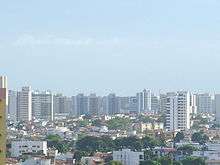Sergipe
| State of Sergipe Estado de Sergipe | |||
|---|---|---|---|
| State | |||
| |||
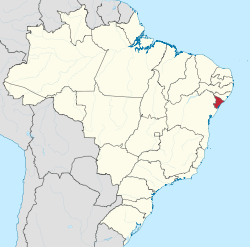 Location of State of Sergipe in Brazil | |||
| Country |
| ||
| Capital and largest city | Aracaju | ||
| Government | |||
| • Governor | Jackson Barreto | ||
| • Vice Governor | Belivaldo Chagas Silva (since 2015) | ||
| Area | |||
| • Total | 21,910.4 km2 (8,459.7 sq mi) | ||
| Area rank | 26th | ||
| Population (2013)[1] | |||
| • Total | 2,228,489 | ||
| • Rank | 22nd | ||
| • Density | 100/km2 (260/sq mi) | ||
| • Density rank | 5th | ||
| Demonym(s) | Sergipano | ||
| GDP | |||
| • Year | 2010 estimate | ||
| • Total | R$ 23,932,000 (21st) | ||
| • Per capita | R$ 12,536 (17th) | ||
| HDI | |||
| • Year | 2010 | ||
| • Category | 0.665 – medium (20th) | ||
| Time zone | BRT (UTC-3) | ||
| • Summer (DST) | BRST (UTC-2) | ||
| Postal Code | 49000-000 to 49990-000 | ||
| ISO 3166 code | BR-SE | ||
| Website | se.gov.br | ||
Sergipe (Portuguese pronunciation: [sɛʁˈʒipi]), officially State of Sergipe, is a state of Brazil.
Located in the Northeast Region along the Atlantic coast of the country, Sergipe is the smallest state in Brazil by geographical area at 21,910 km² (8,459 sq mi), larger only than the Federal District. Sergipe borders on Bahia to the south and west and Alagoas to the north.
Aracaju is the capital and the largest city in the state.
Geography
As with most of the states in northeastern Brazil, inland Sergipe is almost entirely savanna (caatinga), and its coastline is characterized by mangroves, swamps and sandy beaches. A small strip of tropical rainforest runs down the coast.

The São Francisco River forms its northern boundary, and the drainage of the northern part of the state is northward and eastward to that river. The southern half of the state slopes eastward and is drained directly into the Atlantic through a number of small rivers, the largest of which are the Irapiranga (whose source in the state of Bahia is called Vaza Barris at its mouth), the Real and the Cotinguiba. These streams are navigable for short distances, but are obstructed by sandbars at their mouths; because of these, there are no good ports on the coast. The surface of the state resembles, in part, that of Bahia, with a zone of forested lands near the coast and beyond this forested zone lies a higher zone of rough open country, called agreste. There is a sandy belt along the coast, and the western frontier is slightly mountainous. The land in between is very fertile, especially in the forested region where the rainfall is abundant. Further inland, the year is divided into wet and dry seasons with occasional prolonged droughts. These are pastoral areas, and the lower fertile lands are cultivated.
The capital of the state is Aracaju (pop. 479 767 in 2003), on the lower course or estuary of the Cotinguiba River, near the coast. The sandbar at the entrance to this river is exceptionally dangerous, and the port is frequented only by coasting vessels of light draught. The city is found on a sandy plain, and there are sand dunes within the city limits. The main public buildings include a large plain church with unfinished twin towers, the government palace, the legislative halls, a public school and public hospital.
The other principal towns are Estância - pop. 62,218 (in 2005) on the Rio Real river in the southern part of the state and a center for the manufacturing of cotton-based textiles, cigars, cigarettes and soap as well as an active trade center; Laranjeiras - pop. 26,452 (in 2005), located in a highly productive sugar-growing district north of the capital; Capela - pop. 27,403 (in 2005); Simão Dias - pop. 39,706 (in 2005); Lagarto - pop. 90,345 (in 2005); São Cristóvão, formerly Sergipe d'el-Rey - pop. 75,353 (in 2005), which was also the old colonial capital near the mouth of the Irapiranga; and Maruim - pop. 15,937 (in 2005).
History
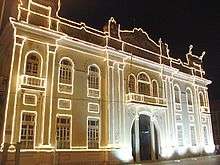
São Cristóvão was the site of the first Portuguese settlement, in 1591, at Sergipe D'El-Rey, which is today Sergipe (the name Sergipe is actually a Tupi word, meaning "river of the crab"), and later became the state's capital for a while.
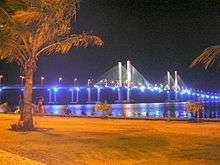
As with other states in the northeast, Sergipe was invaded numerous times by the Dutch, and frequently raided by French buccaneers. During the 17th century, the state was known throughout the Americas for its king-wood, a prized commodity that was the primary attraction during the buccaneer raids, and probably a factor in Dutch military expeditions. From 1641 to 1645, the territory belonged to Dutch-controlled Brazil (New Holland). The Dutch built a fort (the first one in the region) between the rivers São Francisco and Sergipe. In 1645, the Portuguese regained control. By the 18th century, the Portuguese military had driven off the pirates permanently.
In 1855, under the administration of provincial president Inácio Joaquim Barbosa, the capital was moved to Aracaju.
In the 1930s, Sergipe became notorious for its outlaws, including Virgolino Ferreira da Silva, better known as Lampião, the "King of Bandits", who terrorized the state for almost a decade until his beheading by the Brazilian police in 1938. His head was later displayed on a pole in a village square.
Demographics
According to the IBGE of 2008, there were 2,030,000 people residing in the state. The population density was 91.3 inh./km².
Urbanization: 82.2% (2006); Population growth: 2% (1991–2000); Houses: 569,000 (2006).[2]
The last PNAD (National Research for Sample of Domiciles) census revealed the following numbers: 1,240,000 Brown (Multiracial) people (61.08%), 634,000 White people (31.21%), 146,000 Black people (7.22%), 6,000 Amerindian people (0.28%), 4,000 Asian people (0.21%).[3]
Largest cities
| Largest cities or towns in Sergipe (2011 census of Instituto Brasileiro de Geografia e Estatística)[4] | |||||||||
|---|---|---|---|---|---|---|---|---|---|
| Rank | Mesoregion | Pop. | Rank | Mesoregion | Pop. | ||||
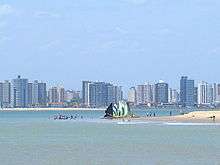 Aracaju |
1 | Aracaju | Leste | 579563 | 11 | Poço Redondo | Sertão | 31253 | |
| 2 | Nossa Senhora do Socorro | Leste | 163046 | 12 | Capela | Leste | 31087 | ||
| 3 | Lagarto | Agreste | 95746 | 13 | Itaporanga d'Ajuda | Leste | 30798 | ||
| 4 | Itabaiana | Agreste | 87746 | 14 | Propriá | Leste | 28533 | ||
| 5 | São Cristóvão | Leste | 79955 | 15 | Porto da Folha | Sertão | 27260 | ||
| 6 | Estância | Leste | 64824 | 16 | Laranjeiras | Leste | 27176 | ||
| 7 | Tobias Barreto | Agreste | 48414 | 17 | Boquim | Leste | 25631 | ||
| 8 | Itabaianinha | Leste | 39175 | 18 | Barra dos Coqueiros | Leste | 25526 | ||
| 9 | Simão Dias | Agreste | 38847 | 19 | Canindé de São Francisco | Sertão | 25218 | ||
| 10 | Nossa Senhora da Glória | Sertão | 32514 | 20 | Nossa Senhora das Dores | Agreste | 24579 | ||
Economy
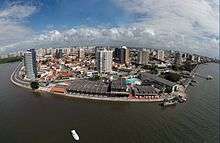
The industrial sector is the largest component of GDP at 53.9%, followed by the service sector at 39.1%. Agriculture represents 7% of GDP (2004). Sergipe exports include: orange juice 66.1%, urea 20.8%, leather and footwear 4.6%, woven goods 2.3%, other types of juices 2% (2002).
Sergipe's share of the Brazilian economy: 0.7% (2004).
Sergipe's economy is focused around the production of sugarcane, and the enormous sugarcane fields, which draw upon the wet and fertile soil, produce over 1.4 million tons of sugar annually. Unlike the situation in many other Brazilian states, cattle is not a major industry, as the land area of the state prevents large-scale grazing. Along with sugarcane, cassava (617,400 tons annually) and oranges (14.4 million oranges annually) are grown. A small-scale leather and textile industry also exists.
The Brazilian federal government is also encouraging the development of a fledgling petroleum and natural gas industry.
Notable residents
- Cleovansóstenes de Aguiar (1926–present): doctor, politician, Mayor of Aracaju (1971-1975) and founder of Sergipe Academy of Medicine;
- Albano do Prado Pimentel Franco (1940–present): entrepreneur, lawyer, politician, Governor (1995 - 2002), Senator (1983 - 1994) and Federal Deputy (2007 - 2010);
- Carlos Ayres Britto (1942–present): judge, poet, President of Brazil's Supreme Court and of the National Justice Council;
- Jackson Barreto (1944–present): lawyer, politician, Vice-Governor (2011–present), Mayor of Aracaju (1986-88 / 1993-94) and Federal Deputy (2003 - 2011);
- Otaviano Canuto Economist, Professor of Economics University of São Paulo USP.
- Vladimir Souza Carvalho (1950–present): historian, judge, writer, Desembargador of the Regional Federal Court (5th Region)
- Edvaldo Nogueira (1961–present): politician, Mayor of Aracaju (2006 - 2012)
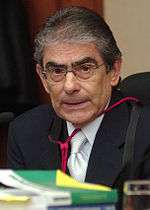
- Josué Modesto dos Passos Subrinho Economist, Professor of Economics Federal University of Sergipe
Education

Portuguese is the official national language, and thus the primary language taught in schools, but English and Spanish are part of the official high school curriculum.
Educational institutions
- Universidade Federal de Sergipe (UFS) Federal University of Sergipe;
- Instituto Federal de Educação, Ciência e Tecnologia (IFS)
- Universidade Tiradentes (Unit) (Tiradentes University);
Infrastructure
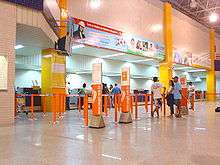
National Airport
Aracaju International Airport was inaugurated on October 30, 1952 with a runway only 1200 meters in length; the airport did not have an access road until 1958, so after construction of one operating efficiency increased. In 1961 the runway was extended to 1500 meters and a passenger terminal was built in 1962. At the time, Sergipe's capital had the worst airport in Brazil. In February 1975 control of the airport was handed over to Infraero.
Highways
BR-101 and BR-235.
Sports
The city has one professional association football team called Club Sportivo Sergipe from the town of Aracaju.
Tourism and recreation
São Cristóvão
São Cristóvão is the fourth oldest town in the country, and was Sergipe's state capital until 1855. It is located some 25 km (16 mi) from the current capital Aracaju.
As a planned urban settlement, the town contains churches and religious ensembles dating back to the colonial period. Most of these monuments are concentrated around the São Francisco Square.
In 1939, São Cristóvão was designated as a National Treasure by the Instituto do Patrimônio Histórico e Artístico Nacional — IPHAN (the Brazilian National Historical and Artistical Heritage Institute). More recently, in 2010, São Francisco Square in the Town of São Cristóvão became a UNESCO World Heritage Site.
Xingó Canyon
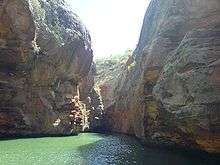

Includes fascinating landscape, rock formations, crystal-clear waters, ecological trails, Caatinga Theme Park, exuberant vegetation and diversified fauna and flora. The Xingó Canyon is located in Canindé do São Francisco, on the banks of the lengthy and well-known São Francisco river. It is the world's fifth most navigable river. The river is formed in a valley reaching up to 170 m deep, being 65 km long and at certain locations between 50 and 300 m wide. The water volume of the canyon is about 3.8 billion m3.[5]
To navigate between the rocks of this gigantic cliff, embedded in the middle of Sergipe’s Alto Sertão, is an unforgettable experience. There are imposing valleys forming a 50 m-high canyon, surrounding a lake that, in certain points, reaches a depth of 190 m. Nests of herons and river islands complete the spectacle. The rocks guard traces of the area’s first inhabitants who lived there more than 8,000 years ago.
There is also evidence of Lampião’s stay there, with his gang of outlaws in less modern times. The Angico trail, in Poço Redondo, leads to a cavern by the same name, where Lampião, Maria Bonita and nine other outlaws lost their lives. Located in the town of Canindé do São Francisco, 213 km (132 mi) from Aracaju, Xingó Canyon is one of the most famous rock formations in the area, embellishing the landscape of the dry Northeastern backwoods. It is hot all year round, but strong winds blowing from December to January keep temperatures at a very comfortable level. Between May and August, it rains frequently.
Flag
The stars on the flag of Sergipe represent the number of river estuaries in the state, and the green and yellow stripes represent Sergipe's union with the rest of Brazil. It was designed by José Rodrigues Bastos Coelho, a businessman who felt that Brazilian ships should carry flags to identify their state of origin. It was officially adopted on October 19, 1920.
In 1937, dictator Getúlio Vargas abolished all state flags and symbols, but they were allowed again in 1946. In 1951, when the Sergipe legislature began to consider restoring the state flag, it decided to change the number of stars, so that there would be one for every municipality in the state. In 1952, this new design was scrapped and replaced by the original 5-star design.
Famous residents
- Sílvio Romero (1851–1914), literary critic and essayist
- Tobias Barreto (1839–1899), poet and essayist
- Clodoaldo Tavares de Santana (b. 1949), footballer
- José Martins Ribeiro Nunes (Zé Peixe), legendary figure who personally leads boats up the river
- Diego Costa (b. 1988), footballer who plays for Chelsea F.C.
- João Batista Nunes de Oliveira (b. 1954), ex-footballer who put the Liverpool off the Mundial of clubs at 1981.
References
- ↑
- ↑ Source: PNAD.
- ↑ (PDF) (in Portuguese). Sergipe, Brazil: IBGE. 2008. ISBN 85-240-3919-1 http://www.sidra.ibge.gov.br/bda/tabela/listabl.asp?z=pnad&o=3&i=P&c=262. Retrieved 2010-01-18. Missing or empty
|title=(help) - ↑ "ESTIMATIVAS DA POPULAÇÃO RESIDENTE NOS MUNICÍPIOS BRASILEIROS COM DATA DE REFERÊNCIA EM 1º DE JULHO DE 2011" (PDF) (in Portuguese). Instituto Brasileiro de Geografia e Estatística. 30 August 2011. Archived from the original (PDF) on 31 August 2011. Retrieved 31 August 2011.
- ↑ "O que o interior de Sergipe tem?". Ministerio do Turismo.gov.br. Retrieved 1 April 2011.
![]() This article incorporates text from a publication now in the public domain: Chisholm, Hugh, ed. (1911). "article name needed". Encyclopædia Britannica (11th ed.). Cambridge University Press.
This article incorporates text from a publication now in the public domain: Chisholm, Hugh, ed. (1911). "article name needed". Encyclopædia Britannica (11th ed.). Cambridge University Press.
External links
- (in Portuguese) Official Website (Agência Sergipe de Notícias - Governo de Sergipe)
- (in Portuguese) History of Colonial Sergipe
Coordinates: 10°35′S 37°23′W / 10.59°S 37.38°W


